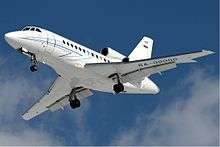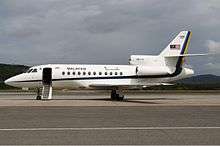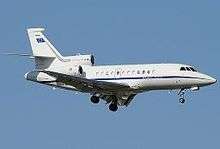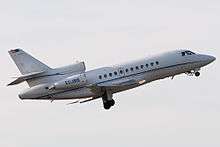Dassault Falcon 900
| Falcon 900 | |
|---|---|
 | |
| Role | Business jet |
| National origin | France |
| Manufacturer | Dassault Aviation |
| First flight | 21 September 1984 |
| Status | Active service in production |
| Primary users | French Air Force Japan Coast Guard Nigerian Air Force Royal Malaysian Air Force |
| Produced | 1984-present |
| Number built | 500+[1] |
| Unit cost |
US$43.3 million[2] |
| Developed from | Dassault Falcon 50 |
| Variants | Dassault Falcon 2000 Dassault Falcon 7X |
The Dassault Falcon 900 is a French-built corporate jet aircraft made by Dassault Aviation. Together with its larger sibling, the Falcon 7X, in 2008 they were the only trijets in production.[3] Both aircraft are notable in featuring an S-duct central engine.
Development
.jpg)

The Falcon 900 is a development of the Falcon 50, itself a development of the earlier Falcon 20. The Falcon 900 design incorporates composite materials.
Improved models include the Falcon 900-B, featuring improved engines and increased range, and the Falcon 900EX featuring further improvements in engines and range and an all-glass flight deck. The Falcon 900C is a lower-cost companion to the Falcon 900EX and replaces the Falcon 900B. Later versions are the Falcon 900EX EASy and the Falcon 900DX. At EBACE 2008, Dassault announced another development of the 900 series; the Falcon 900LX[3] incorporating High Mach Blended Winglets designed by Aviation Partners Inc. The same winglets are certified for the entire Falcon 900 series as a retrofit kit.
Operational service
The Falcon 900 is used by the Escadron de transport, d'entrainement et de calibration, which is in charge of transportation for officials of the French state.
Variants
- Falcon 900
- Original production. Powered by three 20 kN (4,500 lbf) Garrett TFE731-5AR-1C turbofan engines.[4]
- Falcon 900 MSA
- Maritime patrol version for Japan Coast Guard. Equipped with search radar and hatch for dropping rescue stores.[5]
- Falcon 900B
- Revised production version from 1991.[5] Powered by 21.13 kN (4,750 lbf) TFE731-5BR-1C engines.[6]
- Falcon 900EX
- Long range version, with 22.24 kN (5,000 lbf) TFE731-60 engines and more fuel to give range of 8,340 km (4,501 nm; 5,180 miles). Improved avionics (Honeywell Primus). Entered service 1996.[6]
- Falcon 900C
- Replacement for 900B with improved avionics. Introduced 2000.[5][6]
- Falcon 900DX
- Current medium-range production type. TFE731-60 engines.[7]
- Falcon 900LX
- Variant of EX fitted with Blended Winglets designed by Aviation Partners Inc.. Improved range of 4,750 nmi (8,800 km).[8]
- VC-900A
- Italian military designation for the 900EX.[9]
- VC-900B
- Italian military designation for the 900EASY.[9]
Operators
Civil operators

A wide range of private owners, businesses and small airlines operate Falcon 900s.
Military operators



- Bolivian Air Force
- 900EX FAB-001 is presidential aircraft[10]
- Bundesnachrichtendienst (Federal Intelligence Service)
- Italian Air Force operates 5 Falcon 900EX since 2005[11]
- Swiss Air Force: 900EX EASy II (purchased from Monaco)[12]
Former operators
- Royal Australian Air Force - five in service from 1989-2003.
- Government of Greece
- Government of Malawi - A Falcon 900EX purchased in 2009 as a presidential jet, was sold in 2013.[13]
- Military of Malawi
- Government of Monaco, replaced by a Falcon 7X
Accidents and incidents
- On September 14, 1999, a Falcon 900B operating for the Greek Government and registered SX-ECH was descending to land at Bucharest, Romania, when the autopilot disengaged and several pilot-induced oscillations occurred. The impact of unfastened passengers with the cabin and aircraft furniture resulted in fatal injuries to 7 passengers, serious injuries to 2 and minor to another 2. Among the victims was Giannos Kranidiotis, then alternate foreign minister for Greece.[14]
Specifications (Falcon 900B)

Data from Brassey's World Aircraft & Systems Directory[6]
General characteristics
- Crew: Two
- Capacity: 19 passengers
- Length: 20.21 m (66 ft 4 in)
- Wingspan: 19.33 m (63 ft 5 in)
- Height: 7.55 m (24 ft 9.5 in)
- Wing area: 49 m² (527 ft²)
- Empty weight: 10,255 kg (22,608 lb)
- Max. takeoff weight: 20,640kg (45,503 lb)
- Powerplant: 3 × Honeywell TFE731-5BR-1C turbofan, 21.13 kN (4,750 lbf) each
Performance
- Maximum speed: Mach 0.84-0.87
- Cruise speed: 950 km/h (513 knots, 590 mph) at 36,000ft (10,970 m) (Mach 0.85)
- Stall speed: 158 km/h (85 knots, 98 mph) (wheels and flaps down)
- Range: 7,400 km (3,995 nm, 4,598 mi) (7 passengers)
- Service ceiling: 15,500 m (51,000 ft)
- Wing loading: 435kg/m² (91lb/ft²)
See also
- Related development
- Aircraft of comparable role, configuration and era
- Related lists
References
- ↑ http://www.dassaultfalcon.com/en/MediaCenter/Newsd/Pages/PR%202012/500thFalcon900.aspx
- ↑ "Business Jets Specification and Performance Data" (PDF). Business & Commercial Aviation. Aviation Week. May 2015.
- 1 2 http://www.flightglobal.com/articles/2008/05/19/223850/ebace-2008-dassault-announces-falcon-900lx.html
- ↑ Taylor 1988, p.77.
- 1 2 3 "The Dassault Falcon 900". airliners.net. Retrieved 15 May 2009.
- 1 2 3 4 Taylor, M J H (editor) (1999). Brassey's World Aircraft & Systems Directory 1999/2000 Edition. Brassey's. ISBN 1-85753-245-7.
- ↑ "Falcon 900 DX". Dassault Aviation, 2009. Retrieved 15 May 2009.
- ↑ "Falcon 900LX Performance". Dassault Falcon.
- 1 2 http://www.dgaa.it/newsletter/newsletter60/AER-0-0-12.pdf
- ↑ Cicalesi, Juan Carlos; Rivas, Santiago (August 2010). "New Bolivian Presidential Transport". Air International. Vol. 79 no. 2. p. 5.
- ↑ Official website Aeronautica Militare
- ↑ http://www.lw.admin.ch/internet/luftwaffe/de/home/dokumentation/assets/aircraft/falcon900.html
- ↑ Malawi Sells Presidential Jet
- ↑ Accident description for ASN Aircraft accident 14-SEP-1999 Dassault Falcon 900B SX-ECH at the Aviation Safety Network
External links
| Wikimedia Commons has media related to Dassault Falcon 900. |